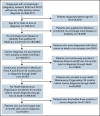Precancer and cancer-associated depression and anxiety among older adults with blood cancers in the United States
- PMID: 34872105
- PMCID: PMC8864638
- DOI: 10.1182/bloodadvances.2021005862
Precancer and cancer-associated depression and anxiety among older adults with blood cancers in the United States
Abstract
For patients with blood cancers, comorbid mental health disorders at diagnosis likely affect the entire disease trajectory, as they can interfere with disease information processing, lead to poor coping, and even cause delays in care. We aimed to characterize the prevalence of depression and anxiety in patients with blood cancers. Using the Surveillance, Epidemiology, and End Results-Medicare database, we identified patients ≥67 years old diagnosed with lymphoma, myeloma, leukemia, or myelodysplastic syndromes between 2000 and 2015. We determined the prevalence of precancer depression and anxiety and cancer-associated (CA) depression and anxiety using claims data. We identified factors associated with CA-depression and CA-anxiety in multivariate analyses. Among 75 691 patients, 18.6% had at least 1 diagnosis of depression or anxiety. Of the total cohort, 13.7% had precancer depression and/or precancer anxiety, while 4.9% had CA-depression or CA-anxiety. Compared with patients without precancer anxiety, those with precancer anxiety were more likely to have subsequent claims for CA-depression (odds ratio [OR] 2.98; 95% CI 2.61-3.41). Other factors associated with a higher risk of CA- depression included female sex, nonmarried status, higher comorbidity, and myeloma diagnosis. Patients with precancer depression were significantly more likely to have subsequent claims for CA-anxiety compared with patients without precancer depression (OR 3.01; 95% CI 2.63-3.44). Female sex and myeloma diagnosis were also associated with CA-anxiety. In this large cohort of older patients with newly diagnosed blood cancers, almost 1 in 5 suffered from depression or anxiety, highlighting a critical need for systematic mental health screening and management for this population.
© 2022 by The American Society of Hematology. Licensed under Creative Commons Attribution-NonCommercial-NoDerivatives 4.0 International (CC BY-NC-ND 4.0), permitting only noncommercial, nonderivative use with attribution. All other rights reserved.
Figures
Similar articles
-
Mental health disorders and survival among older patients with diffuse large B-cell lymphoma in the USA: a population-based study.Lancet Haematol. 2023 Jul;10(7):e530-e538. doi: 10.1016/S2352-3026(23)00094-7. Epub 2023 Jun 1. Lancet Haematol. 2023. PMID: 37271158 Free PMC article.
-
Longitudinal impact of bladder cancer diagnosis on common psychiatric disorders.Cancer Med. 2021 Dec;10(23):8412-8420. doi: 10.1002/cam4.4346. Epub 2021 Nov 12. Cancer Med. 2021. PMID: 34773389 Free PMC article.
-
Impact of comorbid depression or anxiety on patterns of treatment and economic outcomes among patients with diabetic peripheral neuropathic pain.Curr Med Res Opin. 2009 Jul;25(7):1763-73. doi: 10.1185/03007990902997309. Curr Med Res Opin. 2009. PMID: 19505204
-
Social determinants of antenatal depression and anxiety among women in South Asia: A systematic review & meta-analysis.PLoS One. 2022 Feb 9;17(2):e0263760. doi: 10.1371/journal.pone.0263760. eCollection 2022. PLoS One. 2022. PMID: 35139136 Free PMC article.
-
Women's mental health: depression and anxiety.Nurs Clin North Am. 2009 Sep;44(3):355-64. doi: 10.1016/j.cnur.2009.06.002. Nurs Clin North Am. 2009. PMID: 19683096 Review.
Cited by
-
Anxiety and depression among patients newly diagnosed with lymphoma and myeloma.Blood Adv. 2025 Apr 8;9(7):1618-1629. doi: 10.1182/bloodadvances.2024014821. Blood Adv. 2025. PMID: 39841959 Free PMC article.
-
Systematic review of associations between anxiety, depression, and functional/biological aging among cancer survivors.JNCI Cancer Spectr. 2024 Nov 1;8(6):pkae100. doi: 10.1093/jncics/pkae100. JNCI Cancer Spectr. 2024. PMID: 39441826 Free PMC article.
-
The Mediating Role of Depression in the Association Between Death Anxiety and Quality of Life in Elderly Prostate Cancer Patients.Actas Esp Psiquiatr. 2025 Aug;53(4):791-801. doi: 10.62641/aep.v53i4.1921. Actas Esp Psiquiatr. 2025. PMID: 40791044 Free PMC article.
-
A systematic review of coping skill interventions to reduce anxiety and depressive symptoms among adults with hematologic malignancies.Eur J Oncol Nurs. 2022 Dec;61:102224. doi: 10.1016/j.ejon.2022.102224. Epub 2022 Oct 31. Eur J Oncol Nurs. 2022. PMID: 36375304 Free PMC article.
-
Mental health disorders and survival among older patients with diffuse large B-cell lymphoma in the USA: a population-based study.Lancet Haematol. 2023 Jul;10(7):e530-e538. doi: 10.1016/S2352-3026(23)00094-7. Epub 2023 Jun 1. Lancet Haematol. 2023. PMID: 37271158 Free PMC article.
References
-
- Mitchell AJ, Chan M, Bhatti H, et al. . Prevalence of depression, anxiety, and adjustment disorder in oncological, haematological, and palliative-care settings: a meta-analysis of 94 interview-based studies. Lancet Oncol. 2011;12(2):160-174. - PubMed
-
- Hartung TJ, Brähler E, Faller H, et al. . The risk of being depressed is significantly higher in cancer patients than in the general population: prevalence and severity of depressive symptoms across major cancer types. Eur J Cancer. 2017;72:46-53. - PubMed
-
- Polański J, Chabowski M, Chudiak A, et al. . Intensity of anxiety and depression in patients with lung cancer in relation to quality of life. Adv Exp Med Biol. 2018;1023:29-36. - PubMed
-
- Smith EM, Gomm SA, Dickens CM. Assessing the independent contribution to quality of life from anxiety and depression in patients with advanced cancer. Palliat Med. 2003;17(6):509-513. - PubMed
-
- Mystakidou K, Tsilika E, Parpa E, Katsouda E, Galanos A, Vlahos L. Assessment of anxiety and depression in advanced cancer patients and their relationship with quality of life. Qual Life Res. 2005;14(8):1825-1833. - PubMed
Publication types
MeSH terms
Grants and funding
LinkOut - more resources
Full Text Sources
Medical



